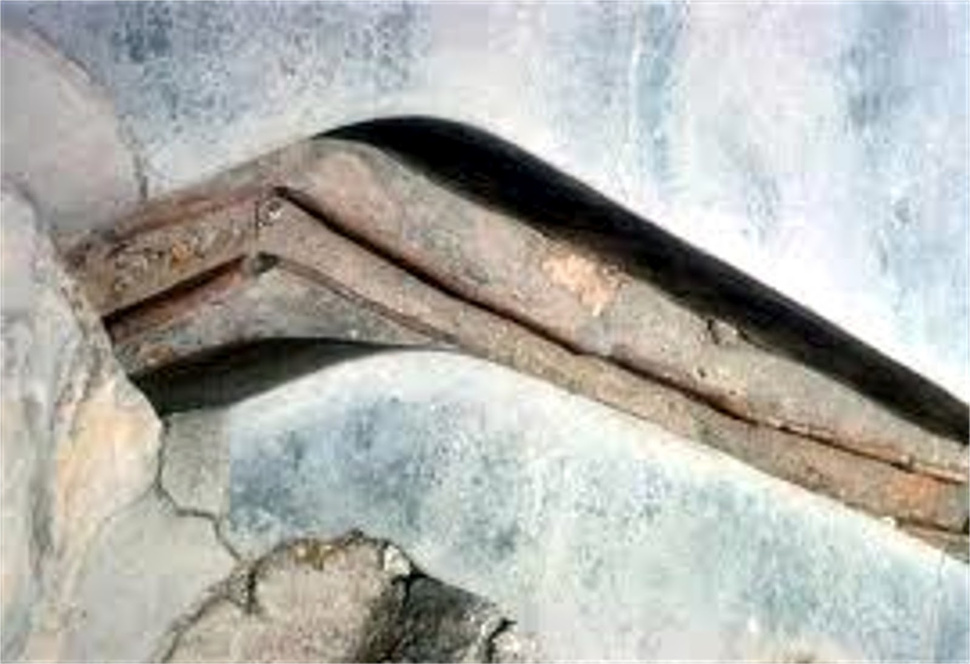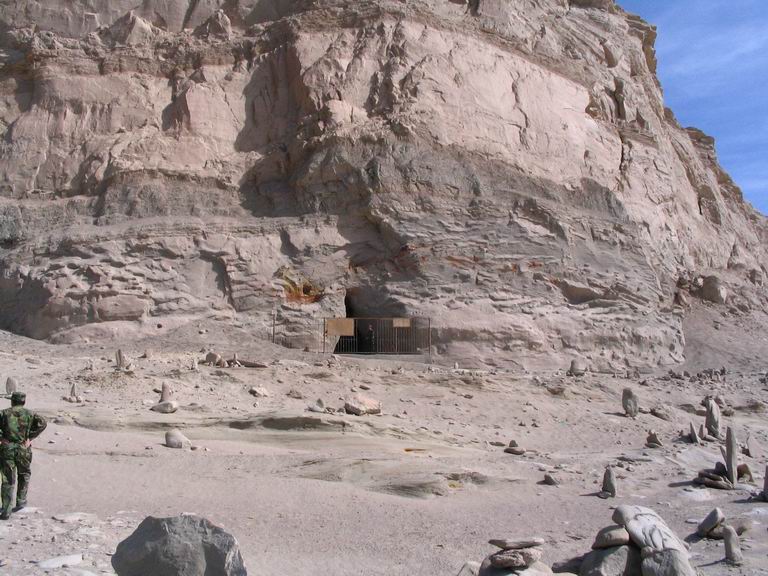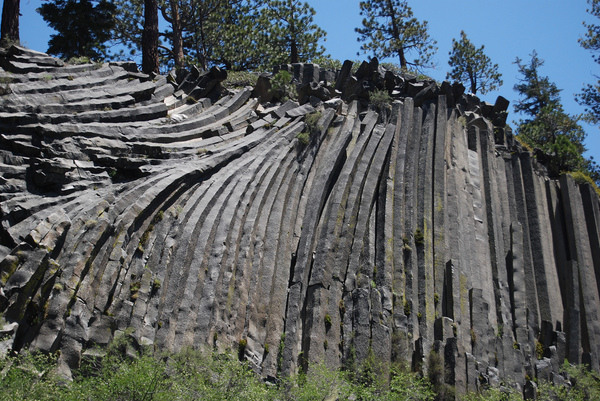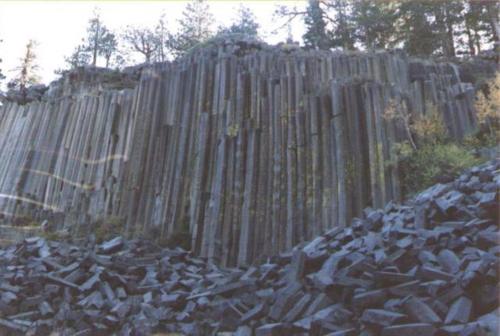
|
|||
150,000-Year-Old Pipes Baffle Scientists in China - Baigong Pipes & Alien Visit
Source : https://en.wikipedia.org/wiki/Baigong_Pipes
The Baigong Pipes are a series of pipe-like features found on and near Mount Baigong, about 40 km southwest of the city of Delingha, in the Haixi Mongol and Tibetan Autonomous Prefecture, Qinghai Province, China. These pipes predate all known history, and are embedded into the rock itself. They are said to lead through the very mountain, and connect to a nearby salt lake. The explanation? Ruins of a construction project 150,000 years ago, by alien visitors. The Baigong Pipes are described as a sophisticated system of metal pipes, buried in geology in such a way that precludes the possibility of having been installed in modern times. They are located on Mt. Baigong in the Qinghai province of China, about 40 kilometers southwest of Delingha. Most accounts describe a pyramid-shaped outcropping on the mountain, and the cave containing the pipes is on this pyramid. 80 meters from the mouth of this cave is a salt lake (the twin of an adjacent freshwater lake), and more pipes can be found poking up along the shore. The site, known by local people as "the ET relics", is on MountBaigong about 40 kilometers to the southwest of Delingha City. On the north of the mountain are twin lakes dubbed as the "lover Lakes", one with fresh water and the other with salty water. The so-called ET relics structure is located on the south bank of the salty lake. It looks like a pyramid and is between 50 to 60meters high.  At the front of the pyramid are three caves with triangular openings. The cave in the middle is the biggest, with its floor standing two meters above the ground and its top eight meters above the ground. This cave is about six meters in depth. Inside there is a half-pipe about 40 centimeters in diameter tilting from the top to the inner end of the cave. Another pipe of the same diameter goes intothe earth with only its top visible above the ground. Above the cave are a dozen pipes of various diameters which runinto the mountain. All the pipes are red brownish, the same color as that of surrounding rocks. The two smaller caves have collapsed and are inaccessible. Scattered about the caves and on the bank of the salty lake area large number of rusty scraps, pipes of various diameters and strangely shaped stones. Some of the pipes run into the lake.
Someone has suggested that the site might have been a launch tower left by ET. The area is high in altitude, with thin and transparent air. Itis an ideal place to practice astronomy, Qin said. In fact, the Purple Mountain Observatory of the Chinese Academyof Sciences has a large radio telescope just 70 kilometers from the site. Yang Ji, a research fellow at the observatory, said the hypothesis of ET relics is understandable and worth of looking into. The cave appeared to have been artificially dug, and was triangular, about six meters deep. Nearby were two similar caves, but they had collapsed and could not be entered. But what struck Bai was the array of manufactured metal pipes protruding up through the floor of the cave and embedded within its walls, one 40 cm wide. Following their path outside, Bai discovered more pipes protruding from the surface of the conical hill, and even more of them 80 meters away from the cave along the shore of the lake. Excited, he removed a sample and sent it to the Ministry of Metallurgical Industry. The result was 92% common minerals and metals, and 8% of unknown composition.  Bai proceeded about 70 kilometers to the Delhi branch of China's Purple Mountain Observatory, a high vantage point from where he knew he could get a birds-eye view of the whole region. He saw great expanses of flat, open terrain, and putting two and two together, he concluded that this would make for a fine alien landing site. Unknown minerals and plentiful landing space meant that the Baigong Pipes had to be of alien origin. Scientists from the China Seismological Bureau visited the lake in 2001 to examine the pipes. Samples brought back to the Beijing Institute of Geology were examined by thermoluminescence dating, a technique that can determine how long it's been since a crystalline mineral was either heated or exposed to sunlight. The result came back that if these were indeed iron pipes that had been smelted, they were made 140-150,000 years ago. Human history in the region only goes back some 30,000 years, and so the alien theory seemed to have been confirmed. The following year the Xinhua news story was published, and the Baigong Pipes entered pop culture as, supposedly, genuine, tangible evidence of alien visitation.  Investigations by experts resulted in the following hypotheses: --Relics of prehistoric human beings. It is believed that prehistoric men held higher industrial and cultural achievements than existing human beings. Relics of their achievements remained after they disappeared with changing glacier conditions. However, no sign of glacier activity was evident around Mount Baigong. --Fossils of plants with tube-shaped stems formed under high pressure. Scientific analysis tells us that fossils of fauna and flora can only remain the same; fossils could not change into forms such as iron pipes positioned in different ways. In addition, there has neither been any report of iron in the surrounding area, nor is there any evidence of fossils. --A unique geological phenomenon. After an investigative tour of the area, Zheng Jiandong, a geology research fellow from the China Earthquake Administration said he favors the possibility that when underground magma rose to the surface ferric materials froze to form the tube-like objects. "There is indeed something mysterious about these pipes," he explained, "for example, the size of the pipes tends to be small and some of them are highly radioactive." --A decision of ET beings. The Qaidam Basin of Qinghai is high in altitude, there are few clouds and air is transparent; while Mount Baigong is very close to the lakes. If an ET being entered our planet in an aircraft, the mountain would be the most eye-catching landmark, and the area would be ideal for landing. Are the pipes used for research into the chemical elements of the Tuosou Lake? Educated guesses and hypotheses have been piling up. However, one thing is certain: stronger evidence and closer scientific analysis are needed before any of the hypotheses can be proven. comments powered by Disqus Submit News/Videos/Links | Discuss article | Article Link More Unsolved and Unexplained Mysteries |
More can be addded on request. Direct your requests at vinit@theunexplainedmysteries.com
